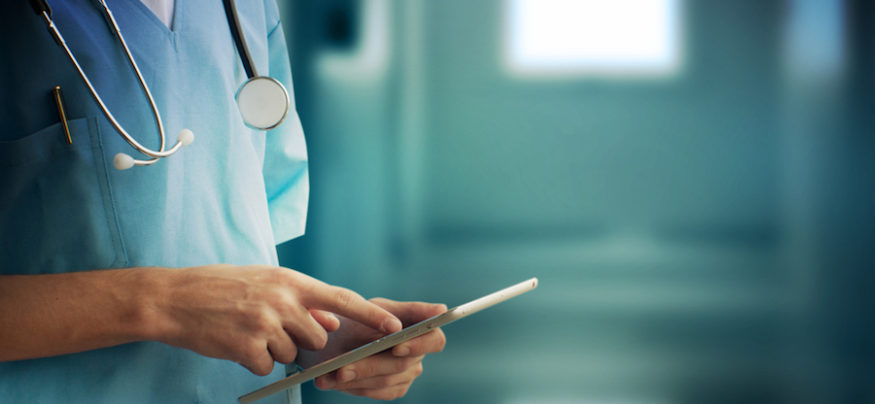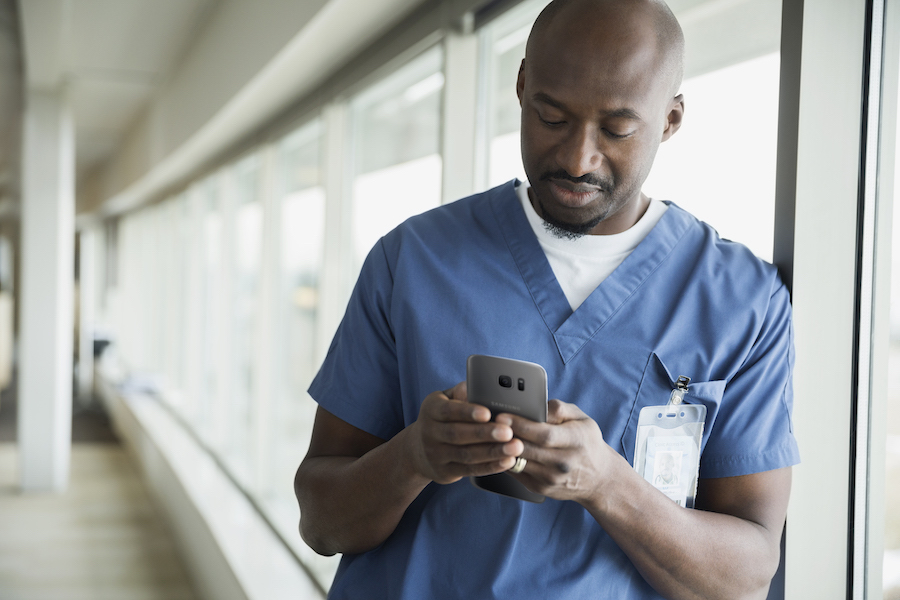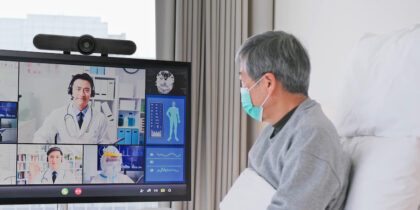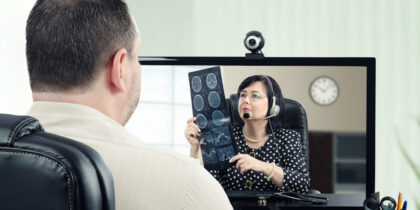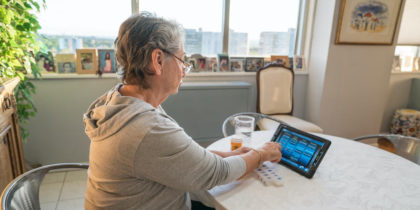Digital technology has been making the rounds in healthcare for years, but now it’s doing more than just streamlining clinical workflows and enhancing the patient experience. At Samsung, we are committed to providing secure digital health solutions that improve the lives and patient outcomes of the healthy, sick and aged to create a better world.
Some of the biggest challenges that we face today as a society include reducing the high cost of healthcare, battling the opioid epidemic and addressing issues that impact the lives of seniors and their families, including loneliness, social isolation and the ability to live safely and independently.
These are big, complicated problems, but it’s clear digital technology can be part of the solution. Here’s how we’re helping.
Reducing the High Cost of Healthcare
We know that greater engagement in a patient’s health leads to better outcomes and lower costs. Digital applications on mobile devices can be highly effective tools to increase patient engagement. They work by providing the patient with virtual lifestyle coaching, real-time reminders and — in some cases — enabling virtual visits with healthcare providers.
BlueStar is an FDA-certified diabetes application from WellDoc that has been shown in randomized controlled trials to reduce HbA1c by 1.9 percent — nearly twice as effective in controlling blood sugar as diabetes medications.
Samsung has partnered with Welldoc to launch the Diabetes Wellness Program (DWP). The DWP, which is integrated within the Samsung Health service, is a 12-week program developed in collaboration with key partners, including the American Association of Diabetes Educators (AADE). It is designed to help adults with type 2 diabetes achieve a healthy lifestyle and manage their condition. Available through the Samsung Health service*, the DWP is powered by WellDoc’s platform that is used in its BlueStar product.
Additionally, working in collaboration with a leading healthcare provider, Samsung has developed and validated a coaching and wellness application for cardiac patients. This application virtualizes the cardiac rehabilitation program on a Samsung Galaxy smartwatch. In a clinical evaluation, at baseline, the standard patient completion rate for a six- to eight-week cardiac rehabilitation program after a heart attack was 48 percent. With the virtual cardiac rehabilitation program, 83 percent of patients completed the program.
How Smart Are Your Clinical Communications?
Take this quick assessment to evaluate your hospital's technology use and get personalized advice. Download Now
The near doubling of the completion rate for the program is remarkable, because we know from randomized controlled trials that for every 37 patients who complete a cardiac rehabilitation program, one life is saved.1,2 We also know that for every 15 patients who complete the program, one hospitalization is avoided.1,3
How did we achieve these results? By virtualizing the program on a smartwatch, we made it easier and more convenient for patients to complete.
We also know that access to care is directly tied to the reduced cost of care, and not only by improving outcomes for high-risk individuals. Greater access to physicians enables people to be more proactive about their health — improving and saving lives by catching potential complications early.
Through a partnership with American Well, we have added a 24/7, telemedicine platform to the Samsung Health app. This enables consumers and patients to connect with healthcare providers to receive urgent care visits, second opinions and disease management programs directly on their mobile device.
Most recently, with the launch of the Galaxy S9 and S9+, Samsung announced My BP Lab, a jointly developed smartphone research app with the University of California at San Francisco (UCSF) Hospitals, to help users manage their blood pressure and stress levels and obtain personalized insights for improving their daily health. My BP Lab leverages an innovative optical sensor available on the Galaxy S9 and S9+ to provide users with richer, more accurate information about their health status. This optical sensor is built into the device, and allows measurement of the heart load factor (HLF), which is obtained by analyzing high-resolution pulse waveforms from the fingertip. Analysis of the waveforms provides information on the load on the heart and blood vessels. The objective of the UCSF research study is to correlate the HLF with blood pressure and stress levels.
These benefits show us there’s no question about how virtual care models and the technology that supports them can help patients — from the hospital to the home. The more connected patients are, the greater value we can achieve by improving healthcare quality and reducing costs across all types of populations.
Virtual Pain Relief
Overdose deaths involving prescription opioids have quadrupled over the past 20 years, and the US Food and Drug Administration (FDA) recently published new guidance documents that highlight the need for more non-narcotic alternatives for pain management.
Enter one unexpected alternative: virtual reality (VR).
It makes sense that a calming VR video could distract from pain in the moment, but these immersive experiences actually produce lasting neurochemical changes in the brain that are visible on a functional MRI (fMRI). These changes are usually sustained for several hours after the VR therapy — in some cases for 24 to 48 hours.
Cedars-Sinai Medical Center, a large community-based hospital in Los Angeles, in a collaboration with Samsung and appliedVR, recently completed a large randomized controlled trial involving 120 hospitalized patients, all of whom were in acute pain. Some patients used Samsung Gear VR headsets and pain management software from appliedVR, while others watched relaxing content on a television.
Researchers found that the VR pain management patients had a 52 percent reduction in pain as compared to the television watchers.
Through our collaborations, we now have an incredibly powerful new tool that can address the opioid epidemic. Our continued partnerships and initiatives with healthcare providers will help physicians and caregivers leverage VR as a highly effective non-narcotic treatment option for suffering patients.
Connected Care Solutions for Seniors
As we age, we face three primary concerns: social isolation, decreased physical independence and diminished mental agility. With the rising number of seniors, together with the recent cuts in Medicare and Medicaid, keeping seniors connected, engaged and cared for requires some deft resource management. How can we care for more seniors with less money? This is where we’ve found success with technology, especially solutions suited for more collaborative and preventive care.
Mobile devices can facilitate greater social connectivity. Breezie, a company based in the UK, US and Australia, has enabled the tablet experience to become much more senior-friendly by automating 43 reconfigurations — such as enlarging icons, locking down certain features and apps and enabling single sign-on — that might be overwhelming for new users to handle manually. Automating these reconfigurations was made possible by leveraging the Samsung Knox customization feature included on Samsung mobile devices. Breezie users report decreased loneliness and social isolation, and — when combined with social engagement programs such as those run by the National Council on Aging (NCOA) — have even demonstrated increased physical and cognitive abilities.
To address the caregiver shortage, Samsung partner eCaring is using emojis on Samsung tablets to make it easier for non-professional caregivers to report daily progress; home sensors from Samsung SmartThings combined with analytics from Billy (formerly Curo) are detecting changes in movement and activity at home that may be worrisome for worsened health; and Samsung wearables powered by Reemo analytics are tracking the health and ensuring the safety of seniors. With these technologies, we now have the ability to translate data into proactive care and keep seniors in better health.
Finally, there’s digital technology that boosts seniors’ independence by addressing age-related disabilities, such as macular degeneration. IrisVision has developed clinically validated software that can help fill in image gaps using the Samsung Gear VR, restoring vision in people with partial blindness. Samsung is also working closely with hearing aid companies PhonAK and Resonance Medical to enable seniors to self-adjust and recalibrate their hearing aids using their Samsung smartphone.
Over time, equipping seniors with mobile devices can provide the necessary foundation for preventive care. Our partners help us create greater connectivity — for patients as well as for nurses, caregivers and doctors.
What’s Next?
Digital health is the new standard in healthcare today, and we are seeing advancements in sensor and device technology on the body (with wearables), around the body (with home sensors) and now even in the body (with implantables). We’re seeing patients and physicians begin to manage surgically implanted devices using smartphones, tablets and wearables.
Medtronic, the world’s largest medical device company, has partnered with Samsung to transform the user experience for patients with diabetes, chronic pain and overactive bladder. No longer will patients need to pull large controllers out of their pockets that call attention to their disease. Instead, they will be able to manage their condition discretely, securely and effectively using consumer-friendly mobile devices.
While displaying patient data on a mobile device is the current standard, Samsung is working closely with its partners and the FDA to redefine what’s possible by customizing the user experience and locking down certain features on Samsung mobile devices to ensure patient safety, data security and, when appropriate, FDA compliance.
Today’s solutions call for extremely sophisticated security and customization. That’s why — thanks to trusted solutions like Samsung Knox that provide device flexibility and data protection — medical companies have continually partnered with Samsung to drive healthcare innovation. As one of nine companies pre-certified by the FDA, Samsung is excited to continually transform the future of medicine.
How smart are your clinical communications? Take our five-question assessment for a personalized recommendations on how to utilize mobile technology at your hospital, or read our free white paper to learn more about improving the quality of patient care and saving on costs using mobile technology.
REFERENCES:
1. Hasnain M Dalal. Cardiac rehabilitation. BMJ 2015;351:h5000 doi: 10.1136/bmj.h5000 (Published 29 September 2015).
2. Anderson L, Thompson DR, Oldridge N, et al. Exercise-based cardiac rehabilitation for coronary heart disease. Cochrane Database Syst Rev. 2016.
3. Sagar VA, Davies EJ, Briscoe S, Coats AJ, Dalal HM, Lough F, et al. Exercise-based rehabilitation for heart failure: systematic review and meta-analysis. Open Heart. 2015;2:e000163.
* The DWP is a wellness tool and not a medical device. It is not intended to prevent, treat or diagnose any disease or condition. The DWP does not provide medical advice and is not intended to replace the judgment of a consumer’s healthcare professional. The Diabetes Wellness Program is available through the Samsung Health app version 5.14, available for download with select carriers on Samsung Galaxy S6 and above smartphones in the U.S.
